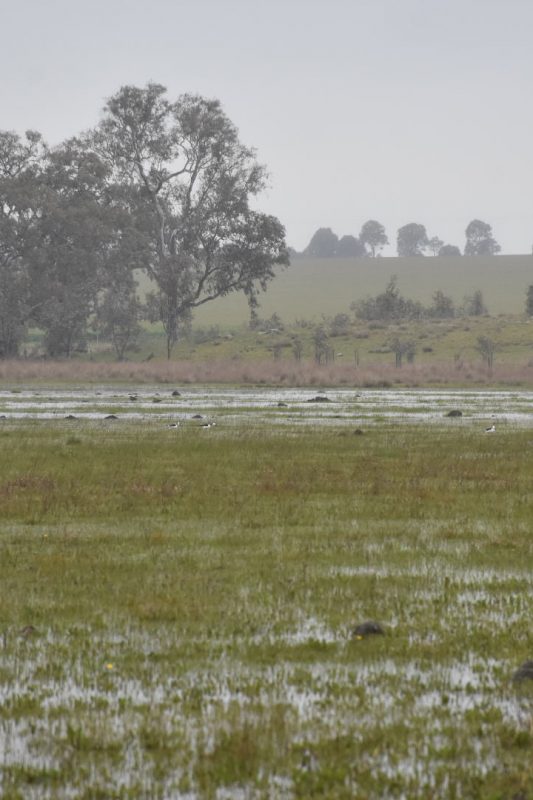Protecting the wetland jewels in our landscape
Trust for Nature supporters visit Long Swamp: Murray Family Conservation Reserve.

Wetland environments are significant in many ways, but there’s one aspect of their biodiversity that often stands out.
“There’s something about wetland birds,” said environmentalist Chris Murray. “They’re obvious and they’re beautiful, and they allow people to enjoy a bit of nature in their busy, everyday lives because if wetlands are preserved carefully, they can thrive so close to urban environments.”
It was a passion for this particular environment and its avifauna that led Chris to complete a PhD on wetlands and water birds in Victoria, and to generously donate funds to Trust for Nature that allowed the organisation to purchase the magnificent Long Swamp: Murray Family Conservation Reserve.
The 178 ha reserve is at the heart of the Moolort Plains wetland complex that lies between Newstead and Maryborough. In the 1960s the swamp was drained as part of a plan to stop rising salinity. Recognising its conservation significance, Trust for Nature purchased the property in two parts: 40 hectares in 1992 and another 138 hectares in 2016, both with thanks to generous donations and support of the local community, in particular the Murray family.
“It’s one of the really good things I’ve done in my life,” Chris said.

It’s estimated that 37 per cent of all wetlands in Victoria have been destroyed since European occupation. A further 30 per cent have been
degraded, and 70 per cent of wetlands are found on private land where they are vulnerable to development, grazing, cropping, and other threats.
Wetlands are often destroyed in dry years when they are not as distinguishable from other habitats.
“Wetlands are so important because they are incredibly diverse
and productive areas when they are inundated, helping sustain not only aquatic species of plants and animals but also dryland species from the surrounding landscape,” Kirsten explained. “They are like the powerhouse of ecosystem health and diversity in many agricultural landscapes, and we really need to protect them.”
Trust for Nature’s updated Statewide Conservation Plan includes targets for wetland conservation. The goal is to increase protection of priority wetlands by at least 5,000 ha by 2030, with a focus on protecting
wetland ecosystems that are recognised as globally or nationally significant, as well as wetland types not well reserved in the public estate.
In the state’s south west, Trust for Nature is working with Catchment Management Authorities and landholders to protect wetland habitat for Brolgas, snipe and bitterns.
“We’ve recently covenanted a spectacular 100 ha swamp near Lake Bolac, which was a real achievement,” said Trust for Nature Conservation
Officer Adam Merrick. “It’s superb habitat for these birds, and it’s surrounded by cropping enterprises so was really a priority for us.”
But protecting wetlands doesn’t just benefit the flora and fauna in that landscape.
“There’s a lovely 8 ha site in urban Portland that is Brolga breeding habitat, though it’s surrounded by houses,” Adam said. “It’s wonderful, because the local community has taken ownership over the wetland and report issues and provide updates.”
Having these natural escapes so close to us, said Chris, has such a positive impact on our lives.
“And as long as they’re protected and given appropriate environments,
they will thrive,” he said. “We need to look after what we have left, for the
environment and for our grandchildren.
“Trust for Nature is doing a wonderful job, and we need to continue supporting their work. Any little bit that one person can do will help.”
Growling Grass Frog. Image: Annette Ruzicka.

The drain was filled in at the end of 2020, allowing the wetland to fill again last year for the first time since the 1960s. Since being inundated, large numbers of waterbirds have been using the wetland, including threatened Hardhead, Blue-winged Shoveler, and migratory terns and crakes.
“Long Swamp Reserve is the only deep freshwater marsh in the Moolort Plains wetland complex, so it’s really significant,” said Trust for Nature Senior Conservation Officer Kirsten Hutchison.
“It protects a large area of cane-grass wetland vegetation and is habitat to so many threatened and vulnerable species. It’s absolutely covered in birds at the moment. It’s providing an amazing and safe place for those animals to be.”
But it’s not just birds benefiting from the landscape’s protection. The vulnerable Growling Grass Frog has also been recorded on the reserve for the first time. Growling Grass Frogs are one of the largest frogs in Australia and their numbers have declined by 50 per cent in the last 10 years due to a fungal disease, habitat degradation, water pollution and predation by introduced fish species.
However while Long Swamp Reserve is a success story, wetlands across the state are still under significant threat.